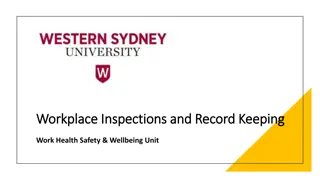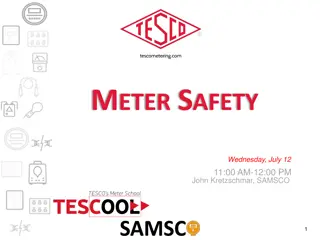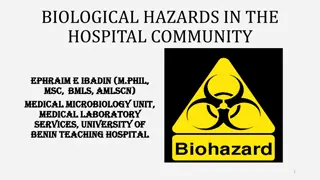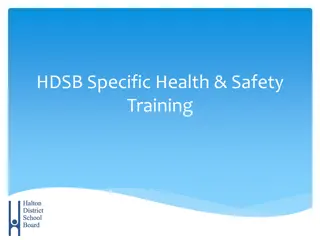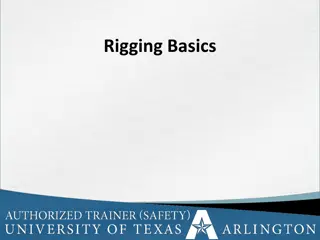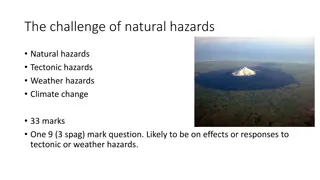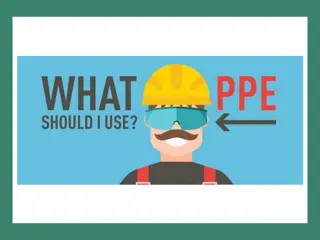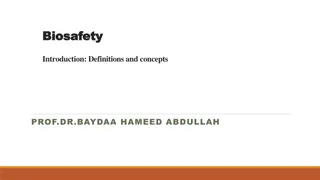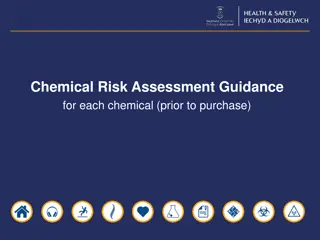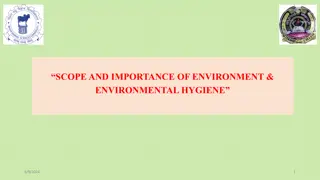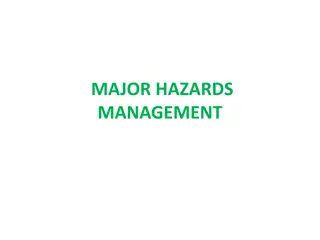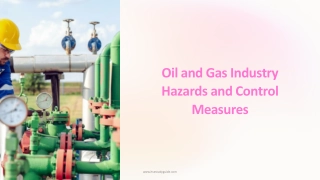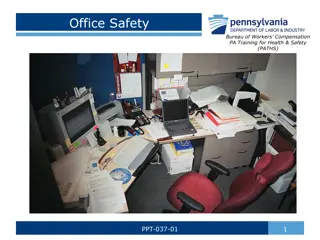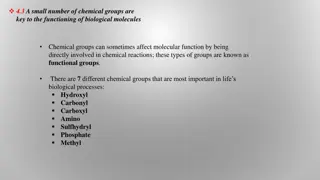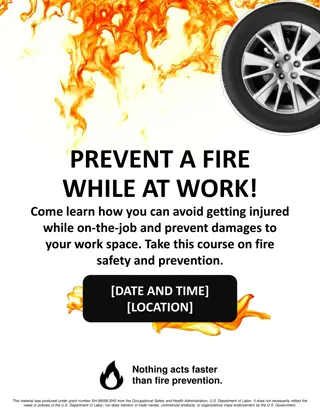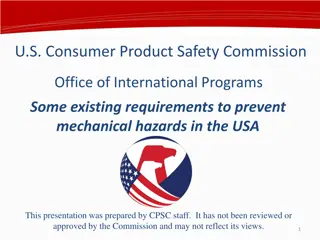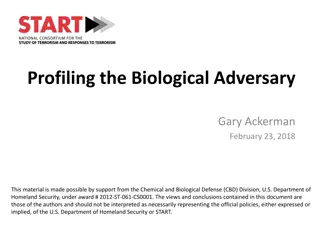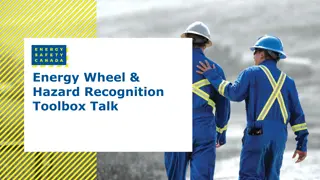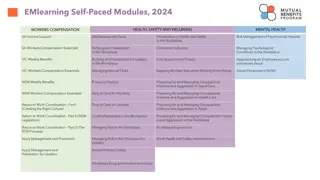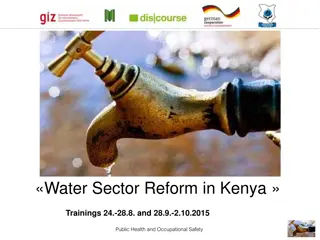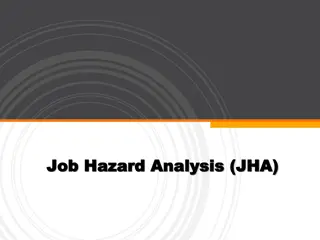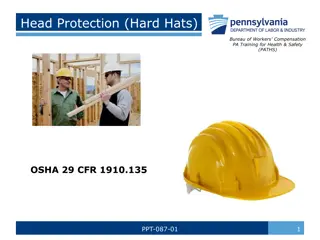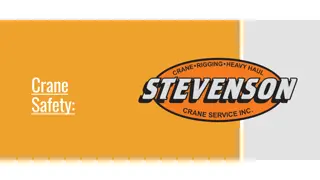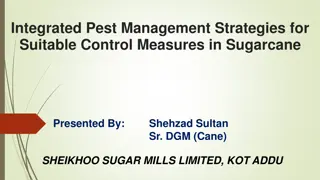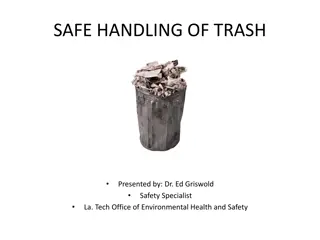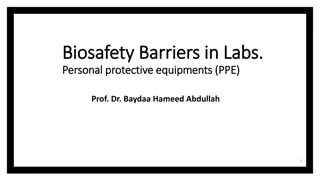Understanding Workplace Safety Hazards: Physical, Chemical, and Biological Risks
Explore the three main types of workplace safety hazards - physical, chemical, and biological - with a focus on identifying potential risks and ensuring a safe work environment. Learn about common hazards such as repetitive motion, chemical exposure, and handling biological materials, essential for promoting safety at work.
Uploaded on Sep 13, 2024 | 0 Views
Download Presentation

Please find below an Image/Link to download the presentation.
The content on the website is provided AS IS for your information and personal use only. It may not be sold, licensed, or shared on other websites without obtaining consent from the author. Download presentation by click this link. If you encounter any issues during the download, it is possible that the publisher has removed the file from their server.
E N D
Presentation Transcript
SAFETY AT WORK COMMUNICATIVE WORKP LACE ENGLISH
HAZARDS DANGERS OR RISKS
THERE ARE THREE KINDS OF WORKPLACE SAFETY HAZARDS
THERE ARE THREE KINDS OF WORKPLACE SAFETY HAZARDS Physical Adapted from English Express, Be Safe at Work, Alberta Employment, Immigration and Industry
THERE ARE THREE KINDS OF WORKPLACE SAFETY HAZARDS Physical Using machines or tools, repeating the same motion over and over, working alone, working in a loud place Adapted from English Express, Be Safe at Work, Alberta Employment, Immigration and Industry
THERE ARE THREE KINDS OF WORKPLACE SAFETY HAZARDS Physical Chemical Adapted from English Express, Be Safe at Work, Alberta Employment, Immigration and Industry
THERE ARE THREE KINDS OF WORKPLACE SAFETY HAZARDS Physical Chemical Using cleaners, working in dust, handling batteries Adapted from English Express, Be Safe at Work, Alberta Employment, Immigration and Industry
THERE ARE THREE KINDS OF WORKPLACE SAFETY HAZARDS Physical Chemical Biological Adapted from English Express, Be Safe at Work, Alberta Employment, Immigration and Industry
THERE ARE THREE KINDS OF WORKPLACE SAFETY HAZARDS Physical Chemical Biological Handling raw meat, dealing with mould, handling blood Adapted from English Express, Be Safe at Work, Alberta Employment, Immigration and Industry
IF THERE ARE HAZARDS IN YOUR WORKPLACE
IF THERE ARE HAZARDS IN YOUR WORKPLACE USE SAFETY GEAR
IF THERE ARE HAZARDS IN YOUR WORKPLACE USE SAFETY GEAR Boots, closed toe shoes
IF THERE ARE HAZARDS IN YOUR WORKPLACE USE SAFETY GEAR Boots, closed toe shoes Glasses, goggles
IF THERE ARE HAZARDS IN YOUR WORKPLACE USE SAFETY GEAR Boots, closed toe shoes Glasses, goggles Gloves
IF THERE ARE HAZARDS IN YOUR WORKPLACE USE SAFETY GEAR Boots, closed toe shoes Glasses, goggles Gloves Mask
IF THERE ARE HAZARDS IN YOUR WORKPLACE USE SAFETY GEAR SAY NO Boots, closed toe shoes Glasses, goggles Gloves Mask
IF THERE ARE HAZARDS IN YOUR WORKPLACE USE SAFETY GEAR SAY NO Boots, closed toe shoes If you feel unqualified or improperly trained to handle the level of hazard or if you think the workplace conditions for the task are unsafe, you can say no. Glasses, goggles Gloves Mask
INJURIES AT WORK TREAT THE INJURY
INJURIES AT WORK TREAT THE INJURY Know where the company first aid kit is located
INJURIES AT WORK TREAT THE INJURY Know where the company first aid kit is located Treat the injury or ask for help in treating the injury
INJURIES AT WORK TREAT THE INJURY Know where the company first aid kit is located Treat the injury or ask for help in treating the injury Tell your manager and they will record an injury report
INJURIES AT WORK TREAT THE INJURY Know where the company first aid kit is located Treat the injury or ask for help in treating the injury Tell your manager and they will record an injury report Tell your doctor and they will record an injury report
INJURIES AT WORK TREAT THE INJURY WORKER S COMPENSATION Know where the company first aid kit is located Treat the injury or ask for help in treating the injury Tell your manager and they will record an injury report Tell your doctor and they will record an injury report
INJURIES AT WORK TREAT THE INJURY WORKER S COMPENSATION Know where the company first aid kit is located If the injury requires treatment, physiotherapy, or time off of work, you can apply for financial assistance from the worker s compensation board. Treat the injury or ask for help in treating the injury Tell your manager and they will record an injury report Tell your doctor and they will record an injury report
INJURIES AT WORK TREAT THE INJURY WORKER S COMPENSATION Know where the company first aid kit is located If the injury requires treatment, physiotherapy, or time off of work, you can apply for financial assistance from the worker s compensation board. Treat the injury or ask for help in treating the injury You will need both the report from your employer and from your doctor to claim worker s compensation assistance Tell your manager and they will record an injury report Tell your doctor and they will record an injury report
Workers Compensation Board 1-866-922-9221 WCB PO Box 2415 Edmonton, Alberta T5J 2S5 www.wcb.ab.ca
PREVENT INJURIES, KNOW THE RISKS
PREVENT INJURIES, KNOW THE RISKS WHMIS
WORKPLACE HAZARDOUS MATERIALS INFORMATION SYSTEM
WORKPLACE HAZARDOUS MATERIALS INFORMATION SYSTEM
WORKPLACE HAZARDOUS MATERIALS INFORMATION SYSTEM Taken from http://provincialcouncils.ca/whmisgame/
WORKPLACE HAZARDOUS MATERIALS INFORMATION SYSTEM Class A: Compressed Gas Taken from http://provincialcouncils.ca/whmisgame/
WORKPLACE HAZARDOUS MATERIALS INFORMATION SYSTEM Class A: Compressed Gas This symbol indicates that the contents of the container are under pressure - anything done to weaken the structure of the container could result in an explosion or a dramatic release of pressure. A compressed gas is a material which is a gas at normal room temperature and pressure, and is packaged under compression. Taken from http://provincialcouncils.ca/whmisgame/
WORKPLACE HAZARDOUS MATERIALS INFORMATION SYSTEM Class A: Compressed Gas This symbol indicates that the contents of the container are under pressure - anything done to weaken the structure of the container could result in an explosion or a dramatic release of pressure. A compressed gas is a material which is a gas at normal room temperature and pressure, and is packaged under compression. Helium and propane are common examples of materials that are supplied as a compressed gas Taken from http://provincialcouncils.ca/whmisgame/
WORKPLACE HAZARDOUS MATERIALS INFORMATION SYSTEM Taken from http://provincialcouncils.ca/whmisgame/
WORKPLACE HAZARDOUS MATERIALS INFORMATION SYSTEM Class B: Flammable/Combustible Taken from http://provincialcouncils.ca/whmisgame/
WORKPLACE HAZARDOUS MATERIALS INFORMATION SYSTEM Class B: Flammable/Combustible "Flammable / Combustible" materials are solids, liquids or gases that will ignite and continue to burn if exposed to a flame or source of ignition. These materials may also be explosive in certain situations or react with other materials to produce a flammable material. Taken from http://provincialcouncils.ca/whmisgame/
WORKPLACE HAZARDOUS MATERIALS INFORMATION SYSTEM Class B: Flammable/Combustible "Flammable / Combustible" materials are solids, liquids or gases that will ignite and continue to burn if exposed to a flame or source of ignition. These materials may also be explosive in certain situations or react with other materials to produce a flammable material. Diesel and gasoline are examples of commonly used flammable materials. Taken from http://provincialcouncils.ca/whmisgame/
WORKPLACE HAZARDOUS MATERIALS INFORMATION SYSTEM Taken from http://provincialcouncils.ca/whmisgame/
WORKPLACE HAZARDOUS MATERIALS INFORMATION SYSTEM Class C: Oxidizing Materials Taken from http://provincialcouncils.ca/whmisgame/
WORKPLACE HAZARDOUS MATERIALS INFORMATION SYSTEM Class C: Oxidizing Materials These materials produce oxygen or another oxidizing substances, which can cause or contribute to the combustion of another substance. Taken from http://provincialcouncils.ca/whmisgame/
WORKPLACE HAZARDOUS MATERIALS INFORMATION SYSTEM Class C: Oxidizing Materials These materials produce oxygen or another oxidizing substances, which can cause or contribute to the combustion of another substance. Chlorine is an example of an oxidizing material Taken from http://provincialcouncils.ca/whmisgame/
WORKPLACE HAZARDOUS MATERIALS INFORMATION SYSTEM Taken from http://provincialcouncils.ca/whmisgame/
WORKPLACE HAZARDOUS MATERIALS INFORMATION SYSTEM Class D: Poisonous and Infectious Taken from http://provincialcouncils.ca/whmisgame/
WORKPLACE HAZARDOUS MATERIALS INFORMATION SYSTEM Class D: Poisonous and Infectious D1: Materials causing immediate and serious toxic effects Taken from http://provincialcouncils.ca/whmisgame/
WORKPLACE HAZARDOUS MATERIALS INFORMATION SYSTEM Class D: Poisonous and Infectious D1: Materials causing immediate and serious toxic effects The effects of Class D1 materials are very harmful based on short-term exposures. Very little exposure can produce serious toxic effects or possibly death. These materials are classified for toxicity based on information such as the lethal dose and the lethal concentration. Taken from http://provincialcouncils.ca/whmisgame/
WORKPLACE HAZARDOUS MATERIALS INFORMATION SYSTEM Class D: Poisonous and Infectious D1: Materials causing immediate and serious toxic effects The effects of Class D1 materials are very harmful based on short-term exposures. Very little exposure can produce serious toxic effects or possibly death. These materials are classified for toxicity based on information such as the lethal dose and the lethal concentration. Cyanide is an example of a material that causes immediate and serious toxic effects. Taken from http://provincialcouncils.ca/whmisgame/
WORKPLACE HAZARDOUS MATERIALS INFORMATION SYSTEM Taken from http://provincialcouncils.ca/whmisgame/


